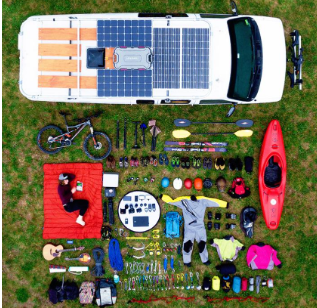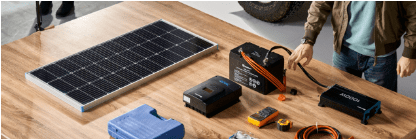Solar energy plays a fundamental role in our vehicles, and we definitely could not do without the system we have. We were enthusiastic about the freedom solar energy is giving us, so we’d write an article describing how it works. The purpose of this text is also to answer many of the questions that were asked of us in the first months of our journey. The doubts we are asked are the most disparate, so that we will give as many answers as possible.
Let’s start by saying that not all of us have the exact needs. Depending on how we each use our vehicle, we create the conditions for which the system must or may not have specific characteristics. There is also the possibility to be considered, which all in all exists, in which the system could be inconvenient in terms of cost benefits. Occasional users of the vehicle and who usually stay in campsites or areas where it is possible to use energy from the electricity grid fall into this condition.
Those who want more independence will have to start thinking about a small solar power system, and we point out how this independence brings considerable savings in costs if it is possible to do without it 100%. The charges in question relate to the areas/campsites that can supply the energy. Naturally, thinking of being 100% independent is useless because you have a sound solar energy system. Still, you need water or an adequate capacity to contain waste liquids for several days of isolation.
Another important factor concerning the motivation that can lead to the installation of a system is given by the goals you want to achieve. Let’s look at some examples: those who particularly like to visit cities often find themselves in unfavourable conditions for a solar system. Buildings, antennas and parks do not facilitate the work of photovoltaic modules. This must be considered before spending money unnecessarily, just as those who prefer to travel to places with an extreme climate could equally find themselves in inadequate conditions to exploit their solar panels system. On the other hand, those who assume a 360-degree use of their vehicle, such as those who are preparing for a long journey, for example, will have to deal with the correct sizing.
Last but not least, the possibility that one’s style of use of the vehicle can change thanks to the fact that, thanks to solar energy, it will be possible to do without plugging in constantly. In this article, we will perform calculations considering the most extreme situation, where the user – as we are doing – needs total independence from the electricity grid. This is used to understand the sizing mechanism, which can be limited in case of sporadic use of locations where it will be possible to reload.
Calculate how much energy you need
To understand what type of system to install, how many panels, how many batteries, and which solar panel inverter, you must first understand how much energy you need. To carry out this measurement – in addition to the datasheets of the devices you have (fridge, lights, computers, mobile phones, water pumps, etc. etc.) – the so-called battery monitors come in handy, tools that remain of fundamental importance even during the regular use of your vehicle’s electrical system
Before throwing an eye on the camping solar panels market, providing a minimum of technical analysis relating to one’s consumption will be good. There are different types of battery monitors on the market, from the stupidest ones that measure the voltage of the batteries to the more useful ones that indicate precisely the amount of amperes entering and leaving them. A battery monitor that directly shows the current input and output Watt value are even more intuitive and easy to use. The market offers a wide choice, as far as we are concerned, the selection of the Battery monitor went to a Renogy product. This measuring instrument offers several essential functions for constantly monitoring the performance of the battery bank, including its temperature.
Why is Watts important? Because they are the power required to carry out an electrical “work”, i.e. the energy needed. This is where confusion generally begins since, typically, in devices related to recreational vehicles, Amperes are often used to indicate their consumption. Why does this cause confusion? Trivially, because on our truck, we will use both direct current and alternating current devices. The alternating current carries much more energy than direct current, and a 12-volt circuit is about 18 times less than a 220 one. For example, a 2 Ampere LED bulb powered by 12 volts will need 24 Watts. The 2 Ampere LED bulb powered by 220 volts will need 440 Watts. Quite a difference! To calculate our need for power expressed in Watts, we will therefore have to use the fundamental rule: Watts = Volts * Amps
We will not go into detail about the different types of batteries on this occasion. Still, to think about any solar system, understanding how much reserve energy you have is of fundamental importance. To understand the importance of this data, let’s think about a typical Camper installation, which includes a pair of 12 Volt 100 Ampere GEL batteries placed in parallel to obtain a 12 Volt bank and a total of 200 Ampere. How much energy do you have?
12 (Volt) * 2 (number of batteries) * 100 (Ampere) = 2400 Watt
Of course, this theoretical figure assumes that the batteries are in perfect condition and fully charged. It is essential to understand that not all batteries are the same. Still, we are thinking about GEL (N.B. slightly more performing than the more common AGM) which on average has a duration of about 1800 cycles if discharged by a maximum of 30% (note that the cycles become 750 if the discharge is 50%). Now, wanting to make our batteries last a while, we calculate 30% of 2400 Watts, thus obtaining 720 Watts which becomes the actual power available to us in order not to stress our investment.
But let’s take a few examples of consumption to give a better idea of how often one’s own is underestimated, especially concerning one’s battery bank, which, as seen in the previous paragraph, plays a fundamental role in calculating daily energy consumption.
- A 100-litre Dometic refrigerator can have an average consumption of around 150 Watts per day (of course, this depends on many factors.
- A standard MacBook computer has a power supply that consumes 85 Watts and requires about two hours of operation to recharge the batteries fully. This means 170 Watts of total consumption.
- A couple of hours a day of reading light with an average consumption of 10 Watts
- About ten minutes of use of the autoclave pump with an average consumption of 20 Watts.
Stopping at these few values, we obtain a total daily consumption of 435 Watts, which allows us to stay within our previously calculated daily capacity of 720 Watts. But what would happen if we turned on a 2000 Watt hair dryer for 10 minutes? This value would bring our daily consumption to 400 + 435, equivalent to a total of 835 Watts which would take us out of our daily availability. Therefore, we understand well how important it is to know your daily consumption to make the correct sizing calculations of the solar system and preserve your investment in batteries. These calculations must also serve to make us understand one thing, namely that – even leaving aside the additional consumption of the hair dryer – we will need to charge the batteries practically every day so as not to consume more than what we have available daily. Is it not clear? Let’s do this calculation:
435 Watts * 2 (days without charging) = 870 Watts
As we have said, we will have 720 Watts of power available with our bench before recharging the batteries. Therefore by consuming 870 Watts (not having recharged), we will go into a deficit of 150 Watts.






























